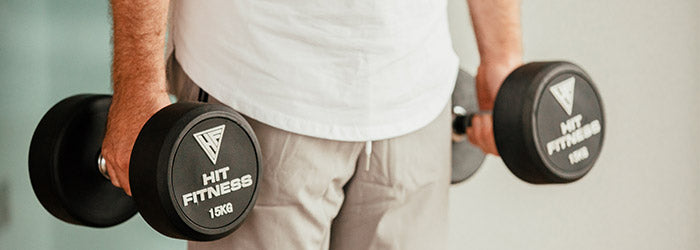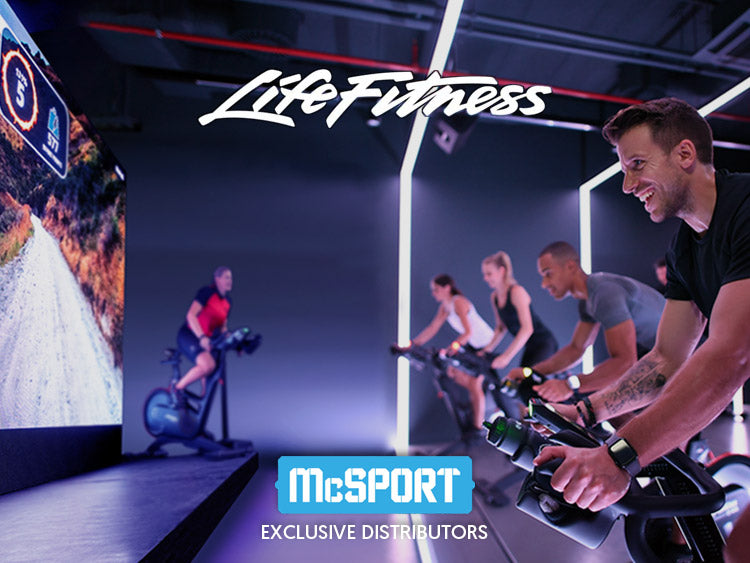If you were to work out on a machine, for instance, you will be working out one major muscle group, whereas a pair of dumbbells can give you a more rounded workout. Before we get into the exercises, you need to have the right weight of dumbbells, suited to your fitness level.
Choosing the right dumbbell set

There are many dumbbell sets to choose from, and the options may be overwhelming. Many go for heavier weights straightaway, which can lead to an injury. Be sure you are getting the right weight for your strength level as it is not a one size fits all. If you are new to dumbbell workouts, then going for a 1kg to 8kg dumbbell may suit your strength level, or if you have some strength training done, a 10kg dumbbell may work better.
Still unsure what weight to get? Why not try a pair of adjustable dumbbells. You can adjust them to your preferred weight and save on cost down the line, as you can slowly increase their weight.
The listed workouts are a perfect introduction to the world of dumbbell training. Each of these exercises targets different areas and will increase your strength while building muscle.
1. Dumbbell Standing Shoulder Press

The standing shoulder press is an excellent unilateral shoulder press that increases shoulder strength, stability, and symmetry. It is an ideal exercise if you want to build muscles in your shoulders.
Steps:
-
Start with your feet shoulder-width apart and a dumbbell in each hand at shoulder height with an overhand grip.
-
Press the weights up until your arms are fully extended.
-
Slowly return to the start position.
If you cannot stretch your arms up fully without your back bending, your dumbbells are too heavy. You need to change to a lighter weight, so you don’t do damage to your back.
2. Dumbbell Squat

The dumbbell squat is ideal for working all the large muscles in your legs. This includes the quadriceps (muscles in front of the thigh), the gluteus maximus (the buttocks), the hamstring (muscle at the back of your thigh), and the soleus (muscles in the calf).
Steps:
-
Start with your feet shoulder-width apart and a dumbbell in each hand, palms facing the side of your legs. Be sure to always keep your head straight, as looking down will upset your balance. This will also help maintain a straight back.
-
Begin by slowly lowering your torso by bending your knees while keeping your head and neck straight. Your knees and toes should be aligned. If your knees are going past your toes, then you are putting too much stress on the knees.
-
As you come back up, begin to exhale and use the heel of your foot to stabilise your legs as you return to starting position.
-
Repeat this for the recommended number of repetitions.
Be careful when doing this exercise— if you are in doubt about what weight to use, we recommend going lighter, slowly increasing the weight if you feel able.
3. Farmers Walk

This exercise is an all-rounder. It targets nearly all major muscles in your body, from your glutes to the trapezius muscle in charge of moving your shoulder bones and supporting the arms.
Steps:
-
Place the dumbbells on the ground slightly in front of you.
-
Bring one leg out in front of you, bend your hips and knees, keep your back straight, and pick the weights up off the ground.
-
Return to standing position, making sure your back does not take any pressure when you pick them up.
-
With the dumbbells on either side of you, begin to walk, bringing your knees up so that they are level with your hip when walking.
-
Choose a comfortable distance, and when you get to that point, place the dumbbells on the floor and begin again.
For this exercise, we recommend doing three sets of 10 reps with a 90-second break in between.
4. Lateral Raise

The Lateral raise is an excellent exercise if you are looking to build muscle in your shoulders.
Steps:
-
Begin with a dumbbell in each hand, down at your side in either a sitting or standing position.
-
Keep your back straight, tighten your core and then slowly lift the dumbbells out to the side until your arms are parallel with the floor, your elbows slightly bent.
-
Bring your arms back in slowly and repeat.
Try to do 10 to 12 reps of these, making sure your arms don’t go over parallel when raising the dumbbells. If you find your arms starting to creep forward, try for a lighter weight.
5. Dumbbell Calf Raise
This is the perfect exercise if you want to strengthen the muscles in your calves. Ideal for runners as it results in better stability and balance, decreasing the risk of ankle and knee injuries.
Steps:
-
Begin by standing upright, holding the dumbbells at your sides.
-
With your toes pointing forward, raise your heels off the floor and contract your claves.
-
Slowly return to the starting position, and repeat.
We recommend starting with three to four sets of 10 reps, making sure your knees stay locked to avoid injury.
6. Bicep Curl

This beginner exercise works the bicep muscles at the front of the upper arm and the muscles of the lower arm. The muscles worked out are vital to everyday life, as they are the ones used when you are picking something up.
Steps:
-
Start with your legs hip-length apart, keeping your abdominal muscles tight.
-
With a dumbbell in each hand, let your arms relax and face your palms forward.
-
Keeping your arms stable and shoulder relaxed, bend your elbow and lift the weights towards your shoulders. Your elbows should stay tucked into your ribs. For the best results, exhale when you are lifting.
-
Slowly return to the starting position, and repeat.
We recommend doing three reps of 5 to 10 of these before taking a 45-second rest.
7. Dumbbell step-up

This exercise is another all-rounder as it can be modified to create a challenging workout for anyone. It is a low impact exercise great for cardio and will build strength equally on each side. It also has the added benefit of increasing balance and stabilisation.
Before we get into the main exercise, there are two things to consider.
-
Step Height: You can use anything for a step, from a chair to the bottom step of your stairs; if you are a beginner, though, the best way to start would be on a low step, between 6 to 8 inches. Once you are comfortable with that height, gradually work your way up to a step that is parallel to your thigh. This will give your hamstring and glutes a workout.
-
Weight: Start with a comfortable weight for your arms that doesn’t cause undue stress on your back. If you are looking to build muscle, you can slowly increase the weight size, but if it is cardio fitness, then a lighter weight but faster repetitions is the way to go.
Steps:
-
Hold the dumbbells in your hands and bring them towards your body, across your collarbones.
-
Use the step and place your right foot on it using your heel to stabilise your leg.
-
Bring your left foot to meet it, and make sure your knees do not go out past your toes. You may need to lean forward slightly making sure not to put too much stress on your knee joint. If you do, try not to round your shoulders. Keep your chest up and out to ensure proper posture.
-
To get off the step, bend your right knee and step down with your left foot bringing your right foot down to meet the left foot on the ground.
Continue this for either a set number of reps or put a minute timer on it if you are just beginning. Remember that your leading leg should do all the work and keep your back straight.
8. Dumbbell Floor Press
The dumbbell floor press focuses on the upper body strength, particularly the chest, triceps, and shoulders. It uses a lot of your core strength so that you will feel this easy exercise.
Steps:
-
Sit on the floor, your legs straight out and dumbbells placed vertically beside them.
-
Take hold of them and bend your legs, placing the base of the dumbbells on your thigh.
-
Slowly lie back and bring up your arms so that you hold the dumbbells up, your elbows in line with your ribs.
-
Hold both dumbbells in a neutral position and begin to slowly extend your arms so that they are above chest level.
-
Inhale slowly and bring the dumbbells back down to the starting position, making sure to control the movement and not let your elbows bounce off the floor.
-
Repeat for the number of repetitions needed.
9. Thrusters

Thrusters are an excellent exercise to help improve coordination, muscular endurance, and balance. It's an ideal exercise if you are looking to work your core, quads, glutes, and shoulders.
Steps:
-
Begin with your legs shoulder-width apart and an overhand grip on the dumbbells. Your hands should also be shoulder-width apart.
-
Keeping your back straight, draw your shoulders back and down while keeping a slight bend in your knees without locking them.
-
Slowly bring the dumbbells to your collarbone or above your shoulders.
-
Ensure that your elbows face forward and tighten your core while expanding your chest as you slowly lower your body into a squat position.
-
If you have the strength, drop your glutes lower as if you are going to sit.
To return into a standing position:
-
Tighten your core once again and turn your knees out slightly for stability.
-
Press your heels to the floor and bring your elbows up as you quickly return to standing.
-
Bring your arms back down and repeat.
10. Weighted reverse lunge
The weighted reverse lunge is good for engaging your core, glutes, and hamstrings. It is an ideal exercise for anyone suffering from hip mobility, knee concerns, or difficulty balancing.
-
Begin by standing up straight with two dumbbells on either side.
-
Step back with your right leg while keeping your back as straight as possible.
-
Keep your knees in line with your toes as you slowly bring them down, breathing in as you do.
-
Push yourself back into starting position as you breathe out.
-
To extend the workout further, you can use the balls of your feet to push yourself back up.
-
If you want to focus on your glutes, use your heels to push up.
Repeat the same movement on the other leg and alternate until you complete the number of reps you want. We recommend starting with three sets of 10 reps per leg with a 45-second break between sets for this exercise.
These exercises will be sure to increase your strength and build muscle. The main tip we can give you is to make sure that you are not putting too much pressure on your back at any point during these workouts. Do this by keeping your back straight and letting your arms, hips, and legs take the weight. An injury to your back can take a long time to heal.












